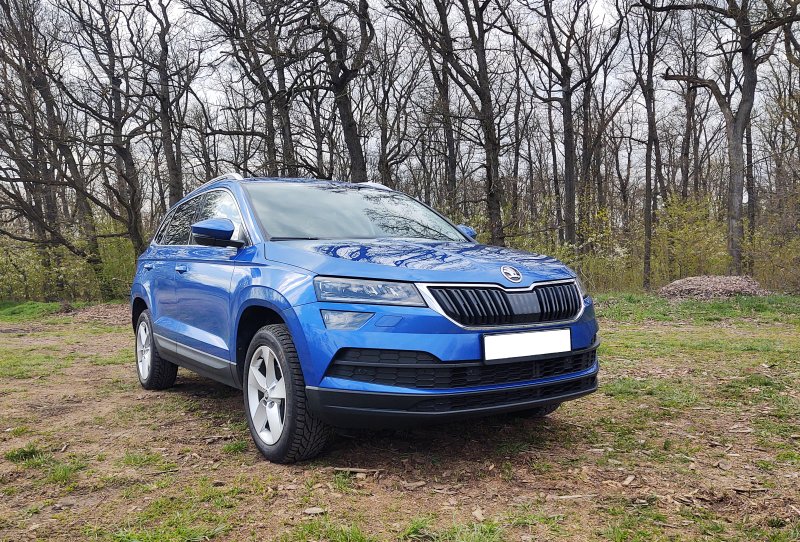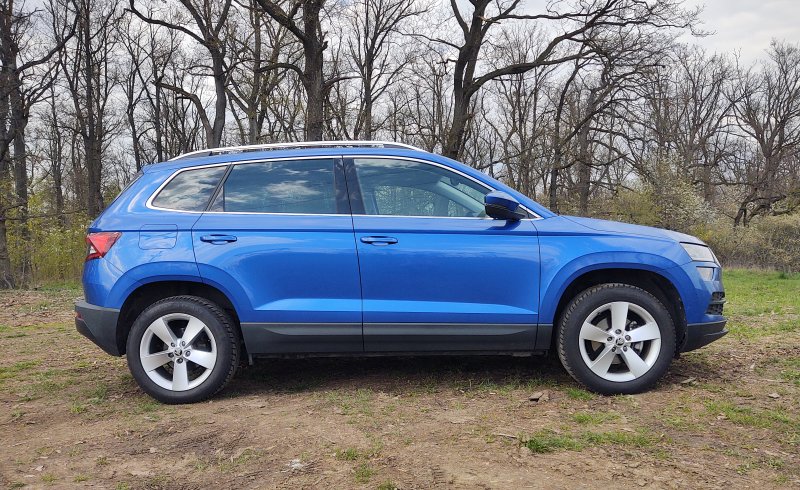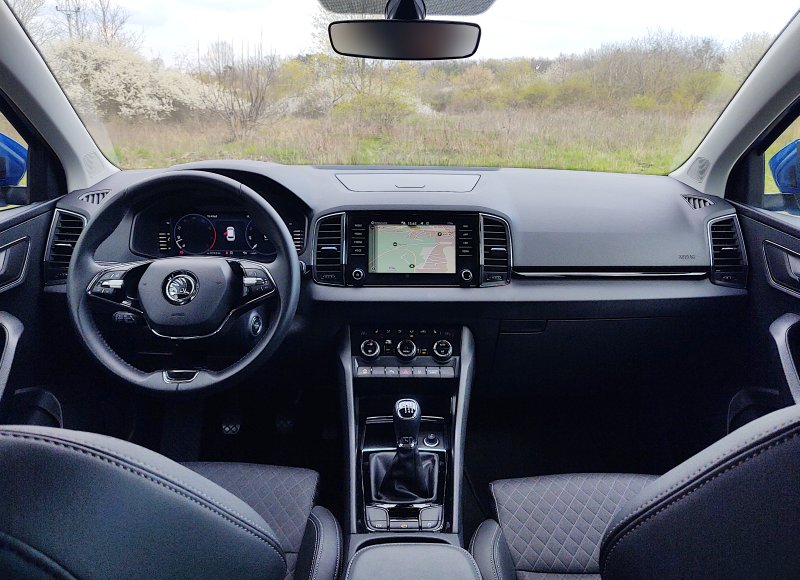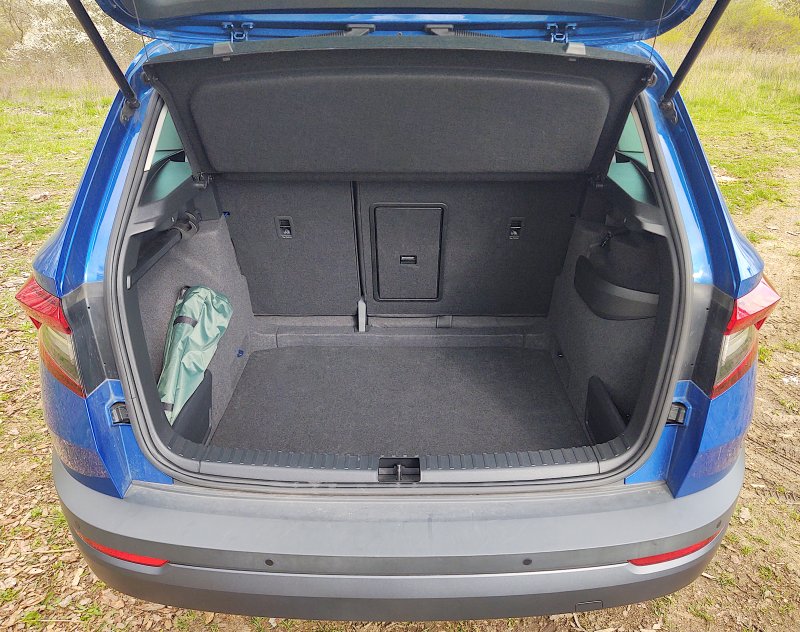Updated: December 27, 2023
The small-medium SUV category is, in the words of Zoolander's Mugatu, so hot right now. Once upon a time, people loved hatchbacks, and then, due to whatever popular pressure, they traded these up for elevated hatchbacks. This means, look left, look right, there's a crossover waiting to be driven.
I chanced upon one Skoda Karoq recently, the post-facelift edition, powered by a 1.5 TSI engine, with cylinder deactivation, front-wheel drive, six-speed manual transmission, and SE L trim level. With 150 HP and 250 Nm of torque, and a 0-100 km/h figure of 9.7 seconds, it's not the speediest vehicle out there, but it promises a good balance of velocity and entertainment. Well, let's explore.

Does it drive as well as it insinuates? Image credits: Skoda Auto a.s.
Exterior
The Karoq is a pretty car. At first, it looks a bit bulky, but then you start to appreciate its curves. It looks rather stylish, even though the rear end is somewhat bland and generic, like most cars built in the last three or four years. Then again, even small SUVs are pretty large by any standard, and they all come with layers of safety equipment that beef up their appearance.


Perchance the photo does not convey it, but 'tis a pretty large vehicle.
The Energy Blue color adds a sophisticated, sporty feel, making the Karoq appear faster than it actually is. Hint, it is fast, we're just talking about the impression of fast-er. This is something the predecessor, Yeti, never quite had, or at least not as much. The wheels could be bigger. The 215/55 R17 set is decent, but I think the Karoq would benefit from 18-inch or 19-inch rims. Again, this seems to be a rather recent trend, possibly due to the whole "green" drama, but newer car models seem to have smaller and narrower tire profiles, which can arguably somewhat reduce fuel consumption and improve comfort on bumpier roads at the cost of aesthetics and grip, although a good driver can compensate for any level of tire profile fuel savings through sheer skill.

The wheel arches have a plenty of room to accommodate large wheel sets.
Interior
Like all Skodas, the level of standard equipment is extremely generous. You get a great mix of practical and fun, and you don't need to sell your kidneys to be able to enjoy the vehicle. Regardless of what you choose, the Karoq comes with alloy wheels, rooftop rails, and no-cost metallic paint. In this particular case, with the SE L trim, the Karoq had cruise control, proper built-in sat nav (and not some smartphone mirroring nonsense), heated seats, and partial leather cover for said seats, with a beautiful checkered stitching pattern.




Everything you need, in one tidy, sensible package.
The interior is spotless. Beautiful, classy, simple. The infotainment system isn't huge, which is good, and you get real buttons for the dual-zone climate and radio/media. Another major bonus selling point in Skoda's favor, because I absolutely detest all-touch controls for vital driving functions. This is a modern car that does not compromise on modern technologies, and yet, it does not compromise on intelligence and ergonomics, either.

It is possible to have a capable infotainment system AND manual controls for aircon! No need for IQ85 features.
The seats are excellent, with tons of lumbar support, and they hug and hold and caress you just so. The slightly elevated driving position is fantastic, and there's ample room, back and front. Arguably, the weakest point here would be the 2/1 rear-bench split, but you can order a set of optional Varioflex slidable and individually foldable rear seats. The luggage area is reasonably large, and fairly deep. It also comes with lots of neat accessories, like pockets and hooks, which you don't often (freely) see in other cars.

I really enjoyed sitting inside the Karoq. It gave me hope that the future isn't all one oversized cheap tablet, and that cars can still be practical without any propaganda and guilt infused into the design. The lack of a hybrid powerplant is a major bonus for me, too.
The driving experience
This is the one aspect of my four-day road test that surprised me the most. The Karoq exceeded all of my expectations, on all levels. I thought it would be a carbon copy of the VW T-Roc, with which it shares the chassis, and which I tested a couple of years back. True, we're talking two different cars, two different engine types and sizes, but they both had 150 HP and manual six-speed transmission. And they are completely different.
In comparison, the Karoq handled better. More specifically, it was livelier, with a more responsive body, throttle and in-between-higher-gears acceleration. It still wobbled and swayed through tighter corners at higher speed, but it never gave the impression of excessive weight and wind susceptibility like the T-Roc. I drove the Karoq at its home turf, in Czechia, on highways, urban roads, and through cities, and the it did exceptionally well. The clutch is soft, the brake precise, the steering a bit sterile but otherwise quite all right. Most importantly, the slew of safety systems did not constantly pester and annoy me like in the T-Roc.

Great visibility, good, confident handling. Soft and firm at the same time.
The Karoq did not try to steer-correct me through corners, there were no annoying pinging noises from this or that module, which actually distract you rather than improve your "safety". Then again, most of the artificial safety systems are designed for the common grunt in mind (who shouldn't actually be driving at all) rather than people who treat driving as a serious responsibility. However, given the presence of the safety systems, they worked with me, rather than against me.

The worst the Skoda did was give me various "eco" suggestions - like shift down below 1350 rpm, shift up here, use your brakes like this, etc. These were shown as text popups on the dashboard. Now, these are still quite annoying and useless, because when one is driving, their eyes should be on the road, not reading text off the dashboard. The pervasiveness of the smartphone technology in our everyday lives, alas, is to be blamed for this, as ordinary people constantly feel the need to "interact" with something, including their car while driving. A dangerous combo, hence the safety systems. Finally, there's the simply question of could vs should. The fact there's enough infotainment system memory to hold a bit more code is no reason to develop software just for the sake of it.
Back to driving. The Karoq drives well. The engine note is pleasing, when you can hear it, as the cabin isolation is solid. You won't notice the cylinder deactivation system kicking in and out as needed. If you need to overtake with haste, yes, you do need to cog down a notch or two, but way less often than say with the 2.0 TDI T-Roc. On twisty, hilly roads, it carried itself with pride, and you don't have to worry too much about gear changes, although you kind of want to. The gear lever has bolt-like precision.
Even the electronic parking brake was okay. I hate the technology, but when executed well, I can only mildly grumble. Indeed, somehow, be it the position of the button, be it whatever, the one in Karoq annoyed me less than with the counterparts.
The Karoq handled the road challenges with flair. And then, the fuel consumption was about 6-7 l/100 km, which is reasonable, given my somewhat more aggressive driving regime, lots of aircon, plenty of people and luggage inside, and the chaotic nature of Czechs roads; you get these "sudden" highway jams before any major junction, where standard, smoothly flowing traffic goes to a crawl in an instant. Then, a bit farther down the road you see the entire right lane lined with truck after truck, for kilometers on end. Such is life.
Problems
There were none that I discerned. The car behaved.
Conclusion
Without overhyping it, this seems like the perfect all-around car for an everyday family. It has everything, including a solid dose of fun. You can potentially go for the 190HP Evo 4x4 version, with the Sportline trim and DSG transmission, if you want a bit more oomph. But beside that, you get a reasonably affordable car with tons of goodies, great looks and comfort, and solid driving characteristics. I knew there'd be a dependable outcome from this review, but I didn't expect to be mildly amazed.
The best part about Karoq is that it does not try to impress. It's a vehicle designed with utility, function and efficiency in mind. And perhaps, the Skodas need to be a little bit conservative so they don't outshine the more expensive brethren in the group, the VWs and the Audis, hence also possibly the lack of even more powerful engines. But even so, the Karoq does exceptionally well. I'd have to say 10/10. Should I ever decide to go for an SUV as my primary car, I will be most strongly inclined to get myself one of these. And we're done.
Cheers.